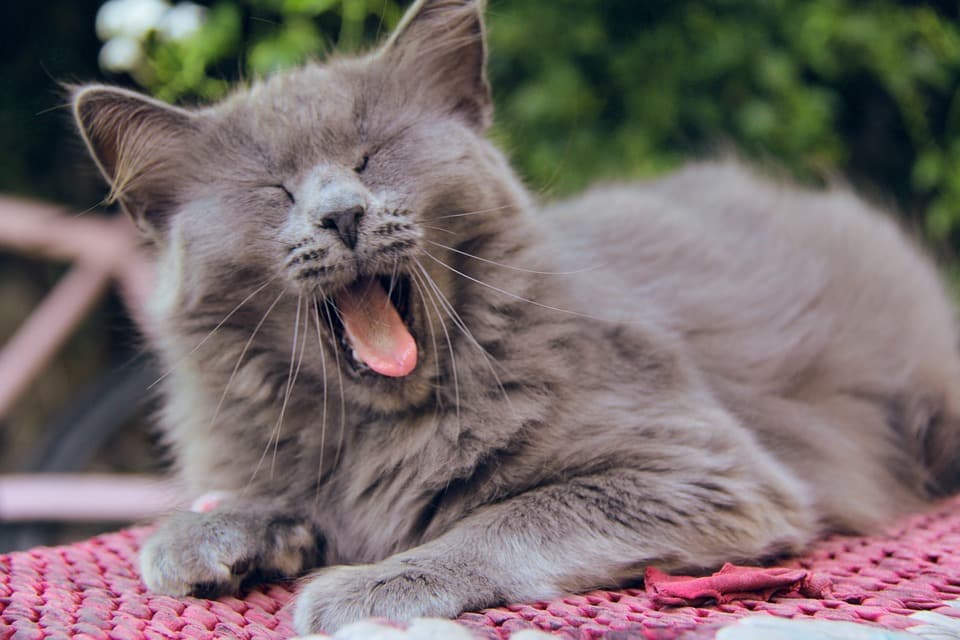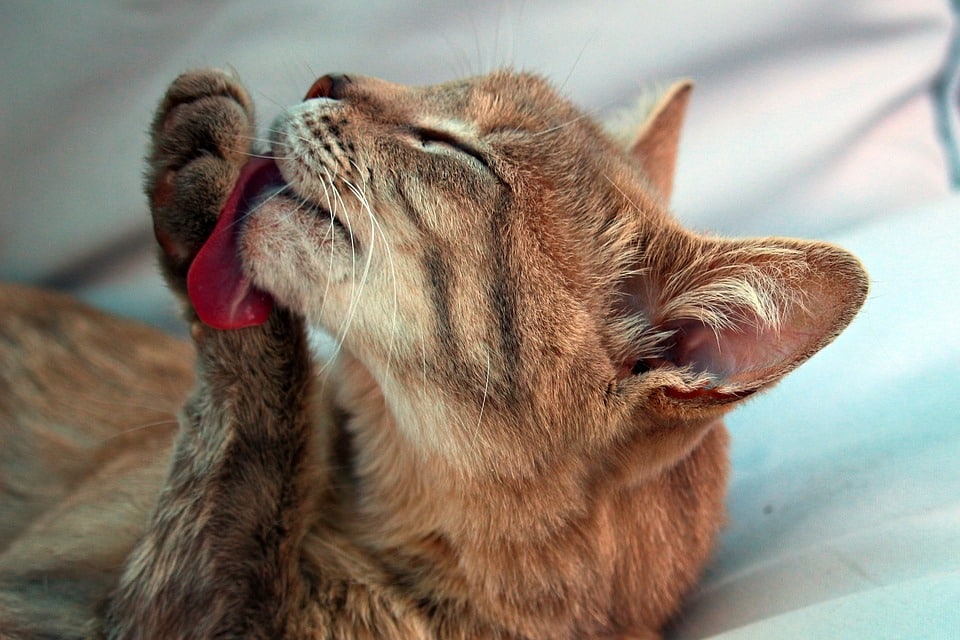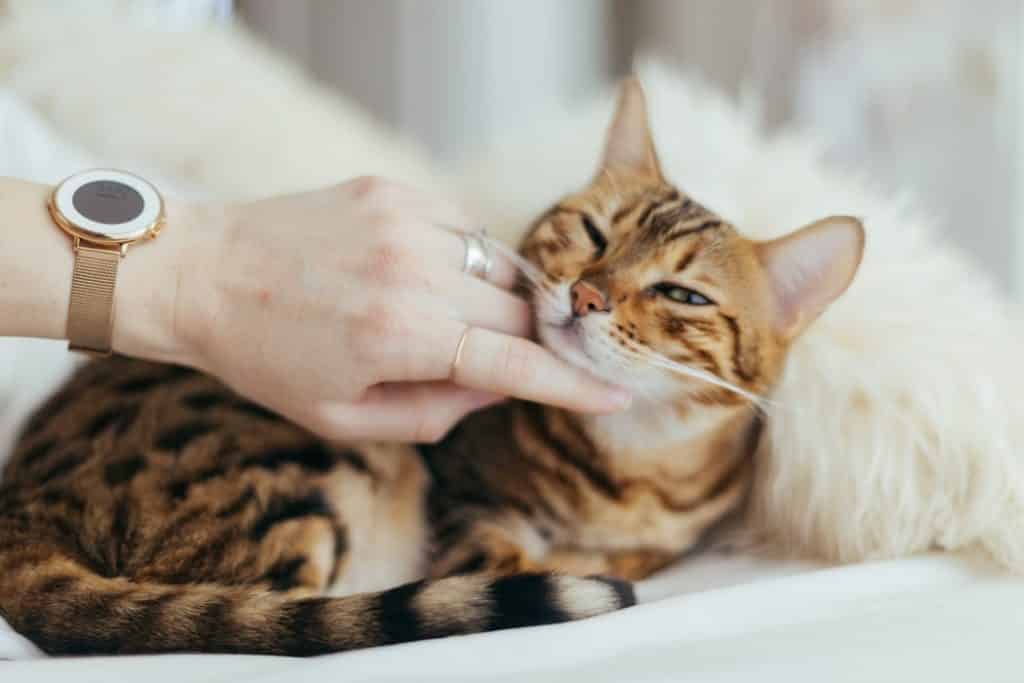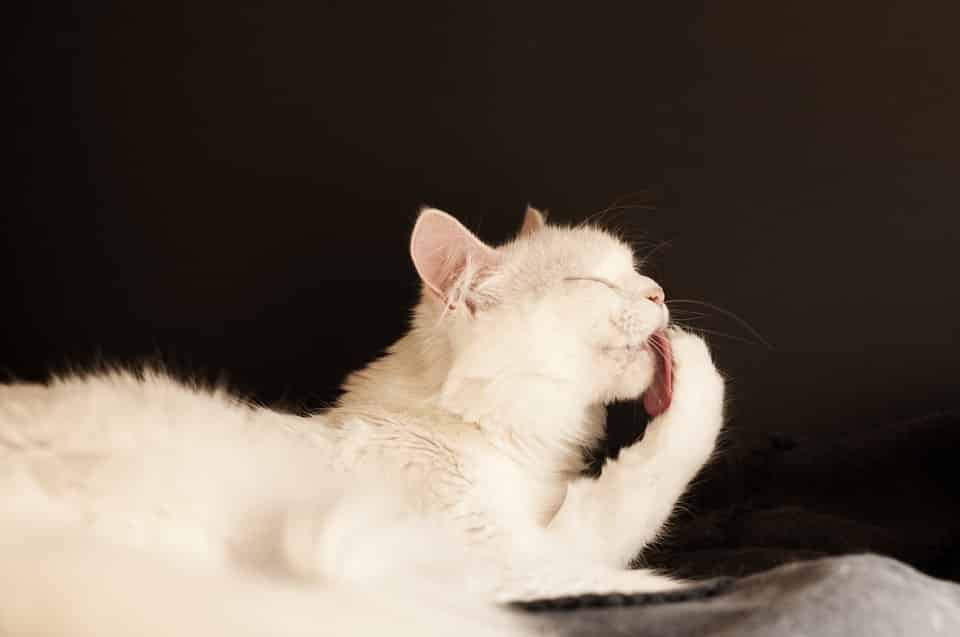- This post contains affiliate links. Read more here.
- Not a substitute for professional veterinary help.
Cats have plenty of mystifying behaviors (what’s the deal with them pushing everything off the counter?!) but one of the grosser feline issues is, without a doubt, cat hairballs.
If you’re a cat owner, chances are you’ve seen your pet vomit up at least one hairball—and if you haven’t yet, trust us, you will.
But what, exactly, are cat hairballs? What are the causes and symptoms? And, most importantly, how can you prevent cat hairballs—and make sure your cat stays healthy, happy, and hairball-free?
What are cat hairballs—and what causes them?
First things first. Before we take a deep dive into all-things-hairballs, let’s first cover what hairballs are and where they come from.
For the record, hairballs aren’t round like a ball. Because they pass through the cat’s esophagus, they’re usually thin and oblong. “Hairballs occur when there is an accumulation in the stomach of the hair cats ingest when they groom themselves,” says veterinarian Robin Downing, DVM, hospital director of The Downing Center for Animal Pain Management in Windsor, CO.
The more hair your cat has, the more susceptible they are to hairballs. “It seems that hairballs are more frequent in cats with medium or long hair, but short-haired cats can also develop them,” says Dr. Downing. Makes sense, right?
A moisture-deficient diet can also cause an increase of hairballs. AKA, if your cat seems to be getting a lot of hairballs, check their food. “Dry kibble contains nowhere near enough moisture for proper passage of hairballs and other food particles,” says Turnera Croom, DVM, a veterinarian with a mobile veterinary practice in Southwest Michigan.
In fact, issues with the GI tract are a major cause of hairballs in cats. “Typically, the feline GI tract can handle a moderate amount of hair, but an inflamed gut, combined with dehydration, is a sure-fire way to have hairball issues,” Dr. Croom adds.
What are the symptoms of cat hairballs?

Pixabay/Rirriz
Now that you know what cat hairballs are (and where they come from), let’s cover how to spot them in your cat.
Obviously, if you see your cat vomit a ball of hair, your cat has hairballs. But there can be symptoms before your cat actually passes the hairball—and, in order to keep your pet safe and comfortable, you need to know what to look out for.
According to PetMD, symptoms of cat hairballs include:
- Gagging, Retching, or Coughing. In order to get hairballs out of their system, cats will gag, retch, cough—pretty much anything they need to do to get that hairball up and out. It can be slightly alarming, but unless they continue the behavior for an extended period of time, it’s nothing to worry about.
- Vomiting. Most cats expel hairballs through vomit. If your cat is vomiting, keep an eye out for hairballs.
- Lack of appetite. A hairball that gets trapped in your cat’s stomach can lead to loss of appetite.
- Diarrhea or constipation. Cat hairballs can cause both loose stools and the inability to pass stools, so it’s important to keep an eye out for both.
- Sudden change in energy/lethargy. Again, if your cat can’t expel a hairball, it can lead them to a sudden drop in energy—and make them appear tired and lethargic.
Typically, hairballs are a harmless nuisance that your cat will be able to pass quickly. But that’s not always the case— and that can lead to potentially serious health issues. If you notice your cat has ongoing hairball symptoms but isn’t able to pass the hairball (either through vomiting or defecating), it’s important to get in touch with your vet to make sure the problem doesn’t progress to something more serious.
“One problem that can arise, if a cat has an underlying disease in the gastro-intestinal tract, is that the hair accumulates in the stomach and forms a large ball that cannot pass in either direction,” says Dr. Downing. “This is called a ‘trichobezoar,’ and the presence of one is a surgical emergency…If a cat has a history of vomiting up hairballs and then goes on to stop eating, or if they retch and nothing comes up, then it is time to call the veterinarian.”
Is there a way to prevent cat hairballs (or at least reduce their frequency)?
Clearly, hairballs are not something you—or your cat—want to deal with on a regular basis. Here’s what you can do to avoid as many of them as possible.
- Monitor your cat’s grooming habits… Cats need to groom themselves to stay clean, healthy, and comfortable. But there is such a thing as too much grooming, and excessive grooming can lead to hairballs. “Some cats will become a little [obsessive] about grooming and actually overgroom,” Dr. Downing explains. Keep an eye out for signs of overgrooming. “If the haircoat is getting thin, or if you notice areas that become bald, call your veterinarian right away.”
- …and help your cat stay properly groomed. As mentioned, cats are great at grooming themselves. But if you want fewer hairballs in your life, you should also plan to help your cat with the grooming process. Without regular grooming sessions, dead hair will accumulate on the surface of your cat’s skin—and when your cat ingests that hair, it can lead to hairballs. For the most effective grooming, Dr. Downing recommends the [easyazon_link identifier=”B07MZD3ZVF” locale=”US” tag=”july2019rover-20″]Furminator[/easyazon_link], which removes dead hair without tugging on the cat’s skin. “The more dead hair you remove, the less will be ingested during grooming,” says Dr. Downing.
- Increase the moisture in your cat’s diet. As mentioned, a moisture-deficient diet is a key cause of hairballs—so increasing the moisture in your cat’s diet is a great way to keep hairballs at bay. “Cats do not drink water as often as their canine counterparts, so they need to get some of their fluids through their food. This is why dry kibble alone is insufficient,” says Dr. Croom. “Adding no-sodium broth or even plain water can be an amazing benefit for kitties [in avoiding cat hairballs].”
- Try food and products specifically formulated to minimize hairballs. In addition to adding more moisture to your cat’s diet, you might also want to try incorporating foods, treats, and other products specifically formulated to help keep cat hairballs away. “There are now nutritional products/profiles that help to reduce the likelihood and frequency of hairballs,” says Dr. Downing. “They tend to be higher in fiber, and they encourage the ingested hair to pass without a problem.” Talk to your vet for hairball-reducing recommendations to add to your cat’s diet.
Are cat hairball products, like lubricants or laxatives, safe for your cat?
Sometimes, no matter how hard you try to prevent it, your cat is going to have to deal with a hairball or two—and there are products on the market (like laxatives and lubricants) that promise to help your cat pass their hairball quickly and safely. But are they good for your cat?
According to the experts, the answer is yes.
“Hairball laxatives are an appropriate treatment to help get kitty’s dry gut lubed up,” Dr. Croom says. “If hairballs do form, hairball laxatives are a good option.”
“Lubricants like [easyazon_link identifier=”B015MA17OU” locale=”US” tag=”july2019rover-20″]Lax’Aire[/easyazon_link] are generally quite effective at helping cats to pass the hair that they ingest when they groom themselves,” Dr. Downing says.
Just make sure you read the label before you give any of these products to your cat. Some products may contain sweeteners, which might make the product taste better but ultimately isn’t healthy for your pet. “I generally guide cat owners not to use products that have malt or molasses in them,” Dr. Downing advises. “The sugar is not good for cats.”
If you don’t have any hairball laxatives or lubricants available, you can also try a natural alternative. And, bonus—you might already have what you need in your pantry. “Alternative treatments for hairballs may be a bit of mineral oil to help the hairball out, or even healthy coconut oil which can give some good fats while eradicating the hairball,” says Croom.
When is it time to contact the vet?
Most of the time, cat hairballs will pass quickly and are nothing more than a nuisance for you and your pet. But, as mentioned, cat hairballs can become a problem when your cat isn’t able to get rid of them.
Get in touch with your veterinarian if your cat:
- Is unable to pass a hairball through gagging, vomiting or defecating.
- If your cat is overgrooming and ingesting more hair than normal.
- If you notice a sudden drop in energy or loss of appetite.
- If your cat has a sudden increase in hairball activity.
Minimize the impact cat hairballs have on your pet
For many felines, cat hairballs are just a part of life. But now that you have the inside scoop on hairballs, you have everything you need to minimize the impact hairballs will have on your cat—and keep your pet happy, healthy, and hairball-free.






